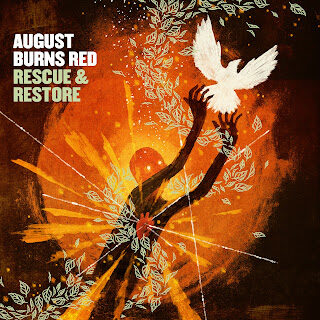
Metalcore: a genre that has been rapidly gaining popularity in the past decade, but in recent years, it hasn’t really been going anywhere. Bands have tried bringing at least something new to the table – most notably djent riffage – but only a select few have succeeded in breathing new life into the genre. One of those bands is Pennsylvania’s August Burns Red. The band experimented a lot on Leveler (and a bit on Constellations, I guess) – whether it be throwing in a salsa part or a few post-rock/post-metal parts – so it’s safe to assume the band was going to continue to experiment with its sound on its newest album, Rescue & Restore, right?
While I was expecting another solid release from August Burns Red, I was a little nervous the band would try too hard to break the mold (again). After Leveler – which, don’t get me wrong, was an above average release – I was hoping ABR would try to recapture its old sound because Messengers has always held a special place in my heart, for it will always be one of my favourite albums of this genre. Did ABR recapture its old sound to a T on Rescue & Restore? Definitely not. Is that a bad thing? Definitely not.
This time around, the experimentation works extremely well for the band, and some examples of this well-done experimentation can be heard on “Treatment” and “Creative Captivity.” “Treatment” can be likened to “Internal Cannon” because of its salsa-inspired interlude, while “Creative Captivity” is something entirely new: it greets the listener with an Eastern Asian instrument (perhaps a lute) that can be heard for a large portion of the track’s playtime. While, for the most part, “Creative Captivity” is instrumental, Jake Luhrs and his vocals can be heard in the background at times and they come in at full volume and force near the end of the track, belting out, “Rescue the beauty that’s left / Restore the character that’s lost since God.” Shortly after, “Creative Captivity” comes to a close with a surprising trumpet solo. Also, I’d like to make note that several other instruments can be heard throughout the nearly five-minute “Creative Captivity,” making it that more interesting. It’s not all just experimentation, though. The August Burns Red that everybody loves is still present: JB Brubaker and Brent Rambler are masters of the fretboard, furiously riffing and soloing away; Matt Greiner proves, once again, that he is one of the best drummers in the world right now; Dustin Davidson makes himself more than noticeable with not only his nifty basslines but also his spectacular backing vocals; Luhrs’ drastically improved vocals have given him much more range to work with; and, collectively, the band has put together some colossal breakdowns. Also, tracks like “Fault Line” and “Provision” are fairly typical-sounding August Burns Red songs (and I mean that in the best way possible because they are excellent) that fans of the old material will particularly enjoy.
While the aforementioned tracks really impressed me, the tracks that really took my breath away were “Sincerity,” “Animals” and “The First Step.” “Sincerity” is loaded with melodic riffs, catchy chugging and beautiful clean vocal gang chants reminiscent of the ones heard on Leveler‘s “Empire.” The main guitar lead in “Animals,” which immediately reminded me of After the Burial’s “Cursing Akhenaten,” is a factor in why the track is another one of my personal favourites. Another reason why I enjoy “Animals” so much is because it has a much darker vibe than the majority of the songs on the album. The same can be said for the album closer, “The First Step”; it’s one of the heaviest tracks on Rescue & Restore and the riffs and mini solos sound spectacular.
Similar to what August Burns Red did on Leveler and what Parkway Drive did on Atlas, the band is truly pushing the boundaries of metalcore (it’s not even fair to label them that now) on Rescue & Restore. Nearly half of the album consists of fresh material for the band – but more so for the genre – and it’s put together ever so brilliantly. The only thing that I wasn’t too fond of is that there seemed to be an interlude in nearly every song; some were only 10-second breaks from the heaviness, but others were much longer. For the most part, the interludes worked exceptionally well and didn’t take anything away from a particular song, but there were a few instances when it felt like the interludes were only there just to be there so the theme could carry on throughout the album.

Links: Facebook – Pre Order



